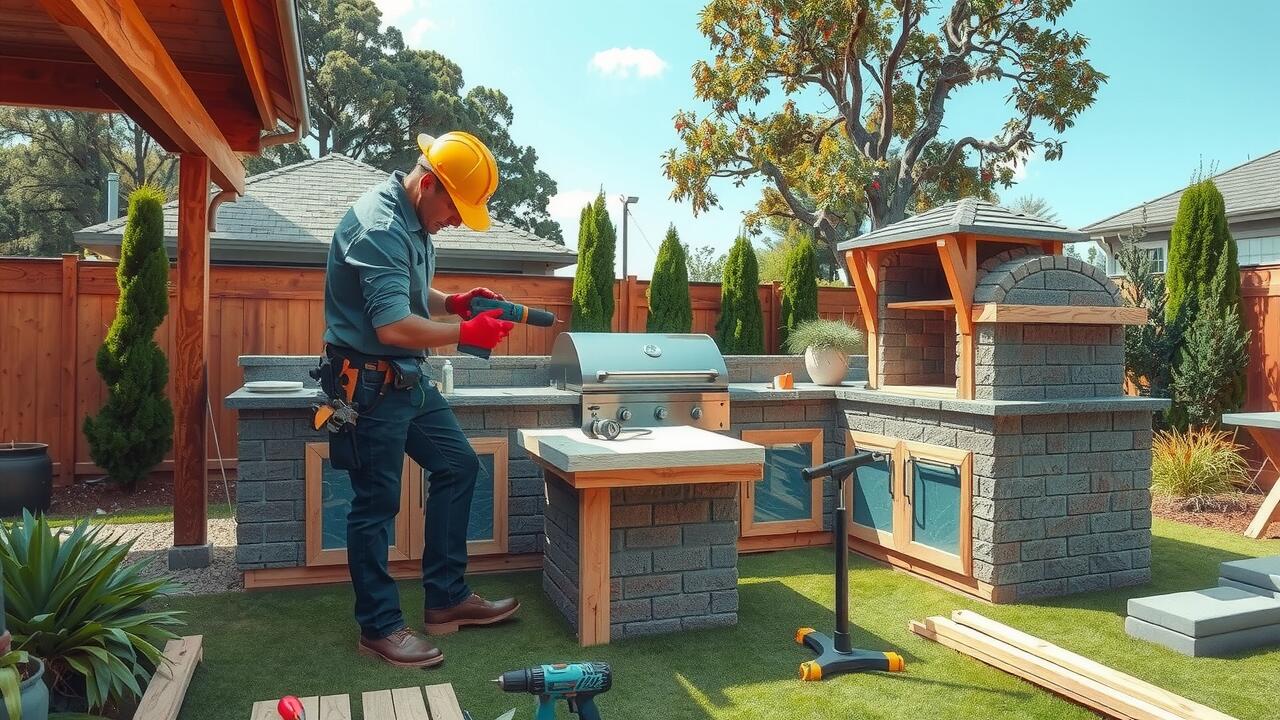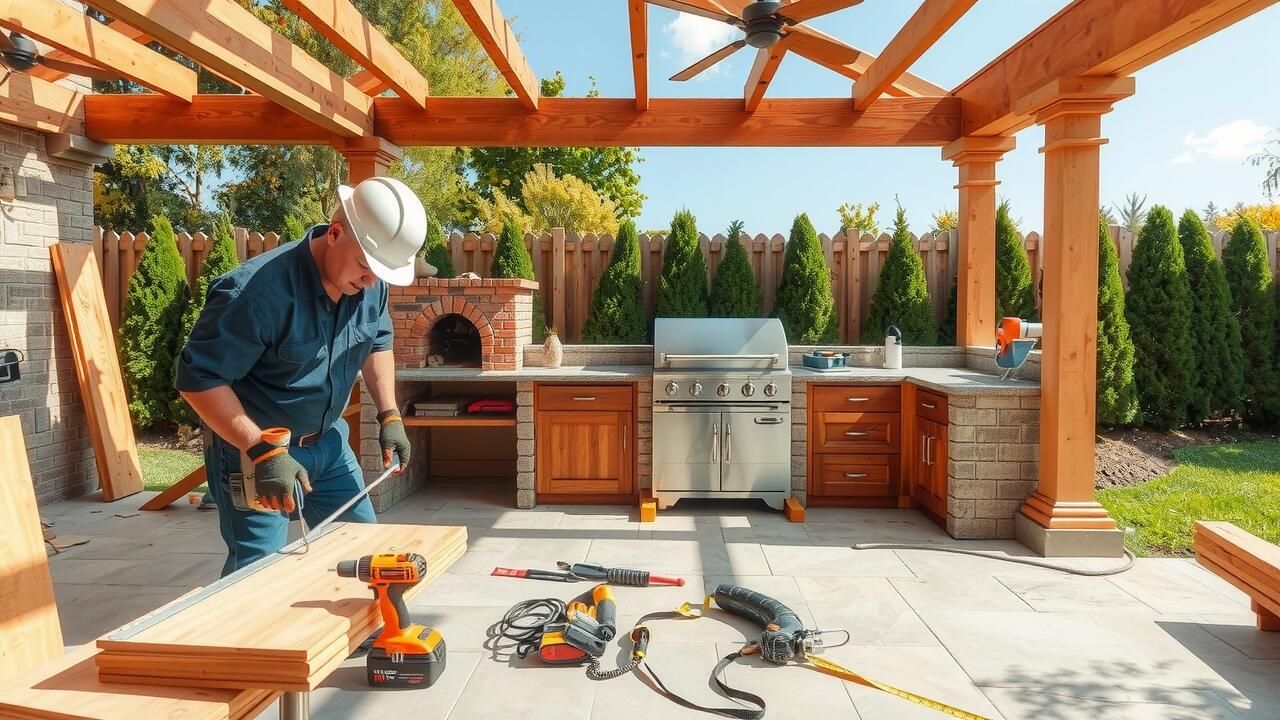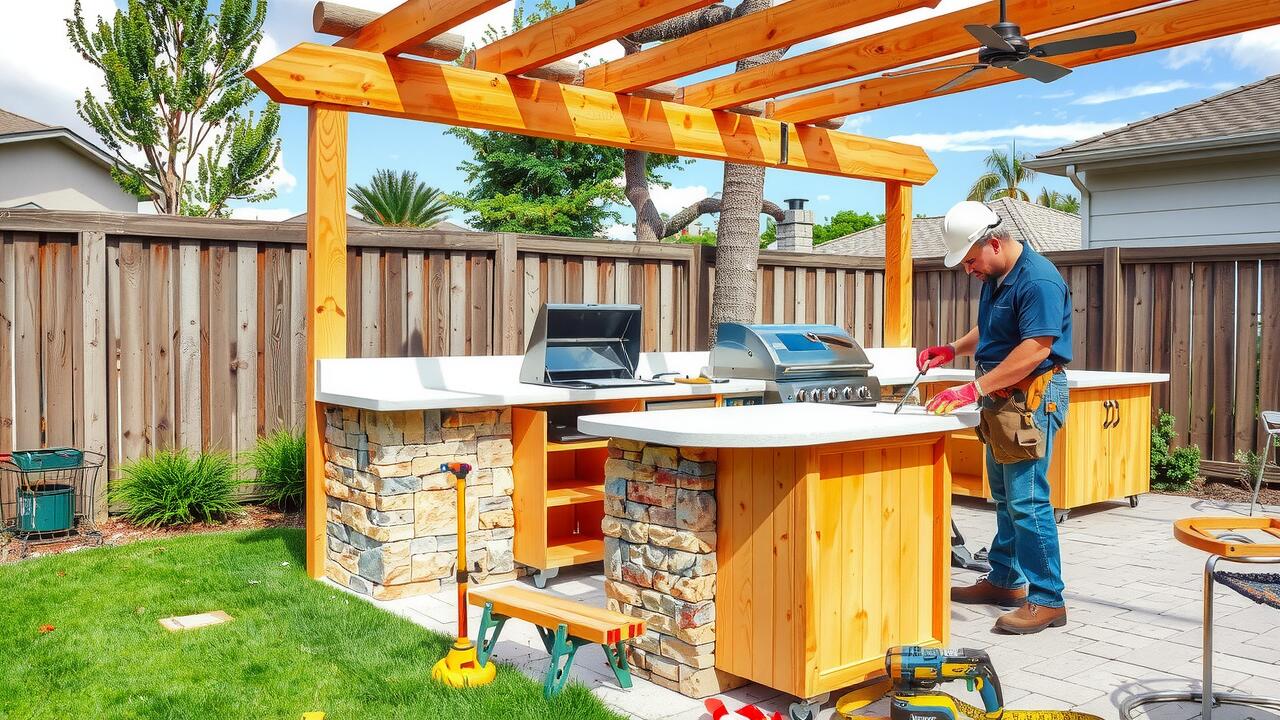
At Houston Home Remodeling Pro’s, we specialize in creating stunning outdoor kitchens that transform your backyard into a culinary oasis. Our expert team works closely with you to design and construct a space that perfectly aligns with your lifestyle and taste, whether you envision a cozy grill station or a full-service kitchen complete with countertops, sinks, and ample storage. We use high-quality materials to ensure durability against the Texas weather, while also incorporating stylish finishes that enhance your outdoor living area. With our dedication to craftsmanship and customer satisfaction, we aim to turn your outdoor cooking dreams into a reality, providing a beautiful space for family gatherings and entertaining friends.
Outdoor Kitchen Design Ideas
Creating an outdoor kitchen offers a wonderful opportunity to blend functionality with design. For those looking to embrace a DIY project, planning an efficient layout is crucial. Consider the placement of essential elements such as gas grills, pizza ovens, and sinks to ensure both flow and accessibility. Using stainless steel for appliances can enhance durability against the elements, while granite or quartz countertops provide a luxurious finish coupled with low maintenance. Incorporating cabinets and drawers not only adds storage but also helps organize utensils and outdoor cooking essentials, making the cooking experience smoother.
Incorporate unique features to further personalize your outdoor kitchen. Adding a gazebo can provide shelter for cooking and dining areas, allowing for year-round usability. For a touch of style, consider using decorative cladding or mosaic tile for an eye-catching backsplash, making the space both practical and visually appealing. Installation of a range hood can improve ventilation, especially when using charcoal or gas grills. Budgeting for quality materials is essential, as it ensures long-lasting performance that withstands weather changes while keeping maintenance at bay.
Inspiring Layouts to Enhance Your Backyard
Creating an inviting outdoor kitchen involves thoughtful design choices that maximize space and functionality. Consider incorporating a pergola to provide shade and enhance the aesthetic of your backyard. This structure can serve as a stylish framework for outdoor dining and cooking areas. Selecting the right materials, such as durable ceramic tile or weather-resistant countertops, ensures longevity while retaining visual appeal.
Arranging the layout with convenience in mind can transform your cooking experience. A barbecue grill paired with a rotisserie can be positioned near a food preparation station for efficiency. Placing an ice maker and a water supply line close to the dining area enhances accessibility for guests. Moreover, using proper framing techniques is crucial for the stability and safety of your outdoor kitchen. The right mix of furniture and utility features will create a seamless transition between indoor and outdoor spaces.
Ensuring Proper Utility Connections
When planning an outdoor kitchen, it is essential to ensure that utility connections are up to code and properly installed. Local building codes will dictate the requirements for gas and electrical lines. Consulting with a licensed plumber or electrician can prevent safety hazards and future issues. Attention to detail in the kitchen layout is crucial, especially when considering traffic flow and the placement of appliances. Using blueprints can help visualize the space and identify the best locations for utility connections.
Proper installation of gas lines for propane grills or natural gas units requires specific materials and techniques. Pipes must be appropriately sealed and tested to prevent leaks. Incorporating adequate ventilation will enhance safety and comfort while cooking outdoors. It is also wise to consider drainage solutions to handle water runoff, particularly if a sink is included. Ensuring that all plumbing and electrical work is performed with precision sets the foundation for a functional and inviting outdoor kitchen space.
Understanding Gas and Electrical Line Requirements
Incorporating proper utility connections is essential for a functional outdoor kitchen. Gas grills, tandoori ovens, and other cooking appliances require specific gas lines to operate safely and efficiently. It’s vital to work with a qualified plumber to ensure that all plumbing systems are up to code. This includes installing durable pipes that can withstand outdoor elements and maintaining sanitary drainage systems. Additionally, for those planning to incorporate electric options like refrigerators or lighting, ensuring adequate electrical lines is just as crucial. Proper insulation and protection against moisture will help extend the lifespan of any connections made.
Safety should be a top priority when dealing with gases and electricity. Adequate ventilation through range hoods and airflow systems is necessary to mitigate the risks of gas leaks or smoke buildup. If you’re opting for electric appliances, selecting the right energy sources, including solar-powered solutions or energy-efficient options, can reduce overall consumption and promote sustainability. Consulting with an expert can help navigate the complexities of installation, ensuring that your outdoor kitchen remains both functional and safe for all cooking endeavors.
Choosing Countertops for Your Outdoor Kitchen
Selecting the right countertop material is crucial for an outdoor kitchen that can withstand the elements while providing functionality and style. Concrete is an increasingly popular choice due to its durability and resistance to wear from heavy use, such as preparing meals for family and friends. With the ability to be customized in various colors and textures, it fits well with any design aesthetic. Another favorite is granite, known for its elegance and natural appeal, which can handle high temperatures from propane grills and withstand precipitation without rusting or degrading.
For those seeking a more modern look, synthetic options like polyethylene and polymer are excellent choices. These materials often feature finishes that resist staining and fading, making them ideal for outdoor environments. When considering countertops, think about maintenance as well; surfaces that are easy to clean will enhance convenience, especially when dealing with spills from burgers or steaks. Durability should be balanced with aesthetic appeal, ensuring that your outdoor kitchen becomes a welcoming space for entertaining.
Exploring Materials That Withstand Weather
When selecting materials for an outdoor kitchen, durability against weather conditions is paramount. Pressure-treated wood is popular for its resistance to moisture, reducing the risk of rot and extending the lifespan of structures like cabinets and bar areas. Stonework offers a robust alternative, with options such as granite and marble providing a luxurious look while standing up to the elements. Concrete slabs are often used for flooring, as they are not only resilient to rain and temperature fluctuations but also easy to maintain.
Incorporating materials that withstand dust and moisture can further enhance the functionality of an outdoor kitchen. Stainless steel appliances resist corrosion and provide a sleek, modern appearance. Weather-resistant fabrics for furniture, like outdoor chairs and canopies, offer comfort without compromising longevity. Using cinder blocks can create sturdy support for grills and other cooking appliances, adding both strength and design flexibility. Properly installed, these materials contribute to a kitchen that is both beautiful and built to last.
FAQS
What are some popular design ideas for outdoor kitchens?
Popular design ideas for outdoor kitchens include L-shaped layouts, U-shaped configurations, and incorporating a bar seating area. You can also consider adding features like a pizza oven, a built-in grill, or a fire pit to enhance your cooking and dining experience.
How do I ensure proper utility connections for my outdoor kitchen?
To ensure proper utility connections, consult with a licensed contractor to assess your space. They can help determine the best locations for gas lines, electrical outlets, and water supply, ensuring they comply with local codes and safety regulations.
What materials are recommended for outdoor kitchen countertops?
Recommended materials for outdoor kitchen countertops include granite, concrete, and stainless steel, as they are durable and resistant to weather elements. It’s essential to choose materials that can withstand heat, moisture, and UV exposure.
Can I install an outdoor kitchen myself, or do I need a professional?
While some aspects of an outdoor kitchen can be DIY, such as landscaping or simple installations, it is advisable to hire professionals for tasks involving gas, electrical, or plumbing connections to ensure safety and compliance with local regulations.
How do I maintain my outdoor kitchen?
To maintain your outdoor kitchen, regularly clean surfaces, check for leaks in gas lines, cover appliances when not in use, and perform seasonal maintenance on equipment like grills and refrigerators. This will help extend the lifespan of your outdoor kitchen and keep it in good working condition.


